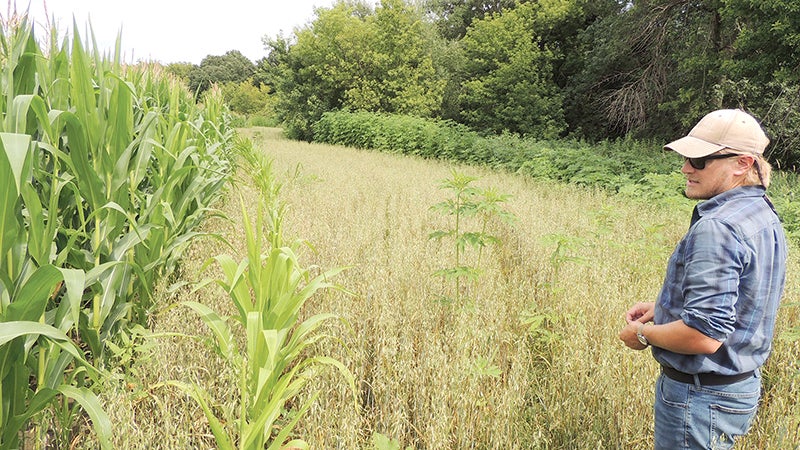Buffer letters going out before Nov. 1 cutoff
Published 8:33 am Monday, September 11, 2017

- Mower SWCD’s Aaron Gamm checks a newly-established buffer in July on Roberts Creek in Waltham Township. Photo provided
By Tim Ruzek
Mower Soil and Water Conservation District
With the state’s Nov. 1 deadline approaching, Mower Soil and Water Conservation District is mailing letters once again to help agricultural landowners in the county comply with the new buffer law.
About 240 letters are going out to landowners in Mower County who have been identified by Mower SWCD as needing to add vegetative buffer to their land along a river or stream deemed by the state to be a public waterway.
These landowners receiving the letter also got a notification letter in January 2017 from Mower SWCD regarding compliance with the Minnesota Buffer Law but have not contacted or had their newly planted buffer approved by Mower SWCD.
“We need to hear from all affected landowners by Nov. 1 to continue working toward full compliance,” said Aaron Gamm, Mower SWCD’s buffer coordinator.
In the new mailing, Mower SWCD provides two options for landowners before Nov. 1, 2017. One option is a Validation of Compliance Request form for landowners who believe their land complies or will comply with the buffer law by Nov. 1, 2017.
The other option is a Conditional Compliance Waiver and Request form providing two waiver choices for landowners who will not comply by Nov. 1 due to their interest in getting technical and cost assistance or not being able to seed buffer this fall.
Under that option, Waiver A is for landowners pursuing or wanting to pursue buffer cost assistance, requiring them to comply a year later by Nov. 1, 2018. Waiver B is for landowners who want to plant buffers on their own next year, which requires them to provide a detailed outline of their plans for seeding and compliance by July 1, 2018.
State lawmakers earlier this year approved the extended deadlines but landowners still need to work with their local SWCD staff prior to Nov. 1, 2017, deadline.
Public waterways are designated by the Minnesota Department of Natural Resources. Public drainage ditches also have vegetative buffer requirements but those won’t need compliance until Nov. 1, 2018.
Buffers are areas or strips of land kept in permanent vegetation – not farmed – to slow water runoff and help filter out pollutants, such as phosphorus and nitrogen, as well as sediment. They also provide wildlife habitat and stabilize land along water.
Under the 2015 law, landowners need to establish on public waterways a buffer averaging 50 feet wide with no less than 30 feet in any spot, unless approved for alternative practices. Public ditches must have at least 16.5 feet of buffer on each side.
Prior to the law, Mower County had 95 percent compliance for acreage along public waterways.
In January 2017, Mower SWCD sent more than 300 letters to Mower County ag landowners who appeared to have land without adequate buffer. Addressing needs on about 400 parcels, the letters included maps and an overview of the buffer law.
About 50 percent of those tagged parcels, however, involve landowners who have yet to communicate with Mower SWCD staff, who continue to provide technical assistance to landowners for measuring, staking, seeding and layout designing for buffers and offer programs that help landowners offset the loss of productive cropland.
One of those options came out in May with the new round of the Conservation Reserve Enhancement Program (CREP) in Minnesota –a voluntary program offering landowners higher payments to permanently protect cropland from being farmed again.
Since the buffer issue emerged, Mower County landowners also have enrolled more than 4,000 acres into the federal Conservation Reserve Program (CRP) that typically involves conservation easements of 10 to 15 years.
For more information on the buffer law, including the cost-share program, contact Aaron Gamm at Mower SWCD at 507-434-2603 or by email at aaron.gamm@mowerswcd.org. You also can visit BWSR’s webpage at www.bwsr.state.mn.us/buffers.


